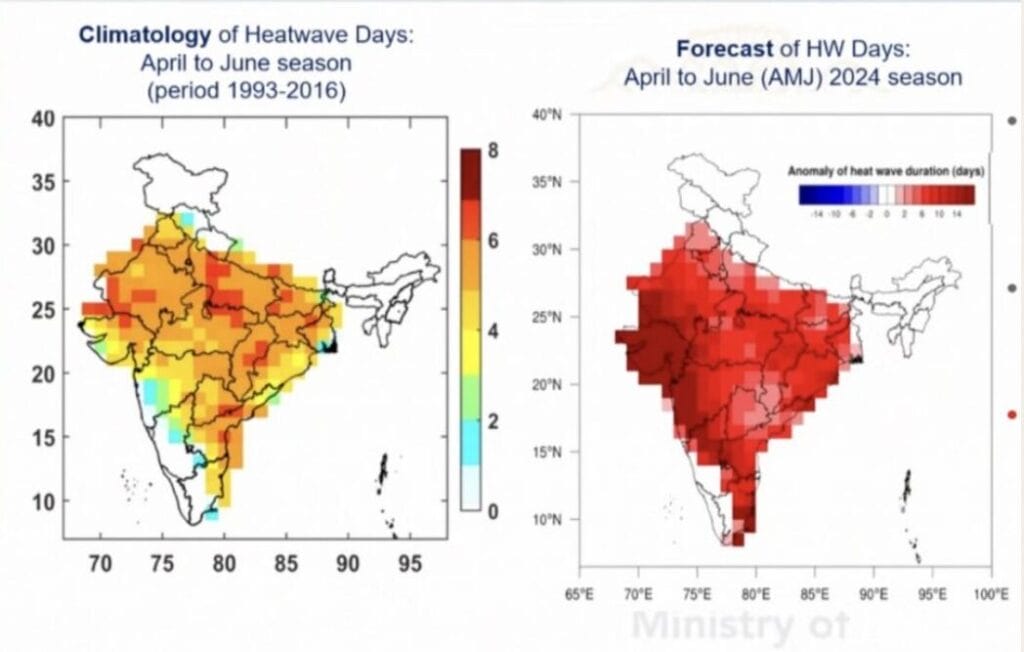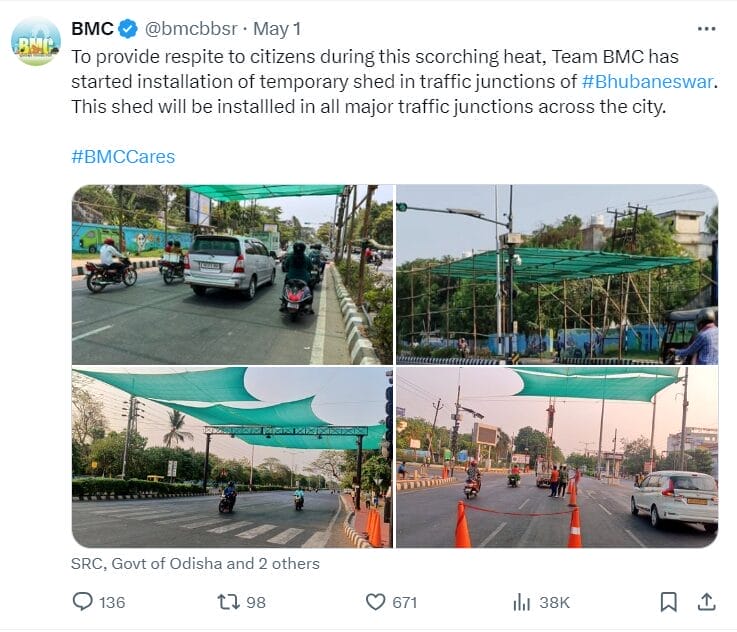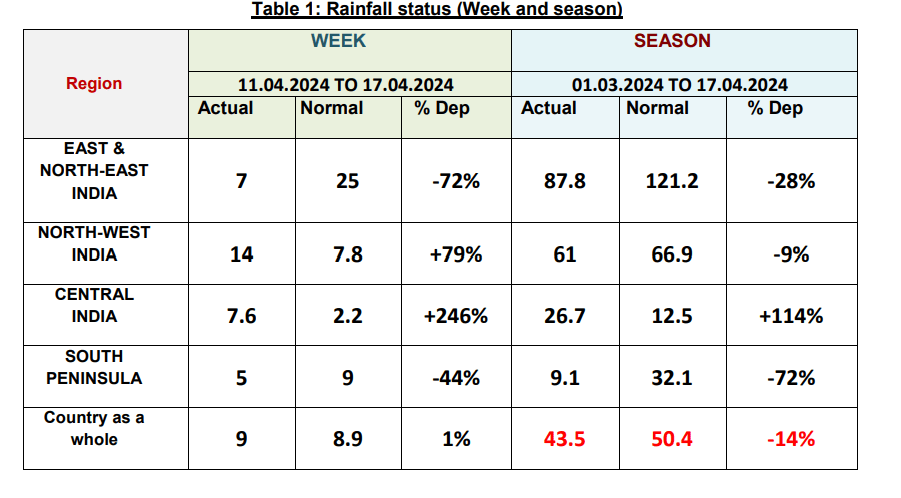Summer in India has been abnormally hot this year and will continue to be so till June 2024, warns the India Meteorological Department (IMD). As reported by The Wire, in a virtual press conference on April 1st, IMD director general Mrutyunjay Mohapatra said that in the months from April till June, most of India will witness temperatures above normal.
IMD’s caution comes at a time when the UN’s World Meteorological Organisation also recently warned that 2024 will likely face worse summers after global heat records across the world.
“During the 2024 hot weather season [April to June (AMJ)], above-normal maximum temperatures are likely over most parts of the country, except some parts of east and northeast India and pockets of northwest India where normal to below-normal maximum temperatures are likely,” the press report stated.
Areas more vulnerable to witnessing increased heat waves include Gujarat, Odisha, Maharashtra, northern Karnataka, Andhra Pradesh and western Madhya Pradesh. Different parts of the country are expecting 10-20 days of heat waves as against the normal of four to eight days. The extended forecast for the next four weeks shows that heat waves and severe heat waves are likely to increase day by day over this time.
“During El Niño years, the heat wave frequency increases. Above normal heat wave conditions are usually observed in El Niño years,” Mohapatra said. The IMD’s April and May forecasts are therefore in agreement with the El Niño forecast, he added. This will flip to El Niño Southern Oscillation (ENSO)- neutral conditions in the monsoon, followed by La Niña conditions which are cooler and wetter by July- September 2024.

Cities across the country breach heat records
Kengeri recorded the highest temperature of 41.8 degrees Celsius in Bengaluru. Bidarahalli also in Bengaluru recorded 41.3 degrees Celsius the same day, according to Karnataka State Natural Disaster Monitoring Centre (KSNDMC). Officials from the India Meteorological Department (IMD), however, said that it is possible that the temperatures have crossed 40 degrees Celsius in Bengaluru. According to IMD, the maximum temperature Bengaluru City observatory recorded was 38.2 degrees Celsius and HAL airport 37.5 degrees Celsius.
On May 1st, Kolkata recorded its highest temperature in 70 years, at 43 degree Celsius. April too brought one of the longest spells of heatwaves in almost two decades and broke many records of heat in recent years. Udhagamandalam, in Chennai, smashes all-time temperature record witnessing 29 degree Celsius for the second consecutive day. Several parts of Tamil Nadu breached 40 degree Celsius in the last week of April.
Mumbai continued to face severe heat waves for the third consecutive day, recording a maximum temperature of 38.4 degrees Celsius. In Thane the temperature soared to 42 degree Celsius. The hottest April day of the decade had been recorded earlier too this month on April 16th when the city touched a scorching maximum temperature of 39.7 degrees Celsius.
Dry spells and heat waves costing lives and crops
Increased temperature in the country has cost at least nine lives in the country. In April, West Bengal recorded the most number of heatwave days for the month in the last 15 years, followed by the neighbouring coastal state of Odisha where heat conditions were the worst in nine years. Authorities have also declared a rare heatwave in Kerala, where at least two deaths have been recorded due to soaring temperatures. Maximum temperature in Kolkata reaches 43 degree Celsius and IMD has issued an orange alert for heat waves in the city. Bengaluru has not witnessed rain in the month of April for the first time since 1989 and recorded a maximum temperature of 39.2 degree Celsius.
Heatwaves pose significant risks, especially for vulnerable populations like the elderly, children, and those with pre-existing health conditions, who are more susceptible to heat-related illnesses such as heat exhaustion and heatstroke. Additionally, prolonged periods of extreme heat can lead to dehydration, and strain infrastructure such as power grids and transportation systems, the IMD said.
Read more: The trials of being an urban farmer in Delhi’s Yamuna floodplains
Prolonged dry spell in the coffee districts in India will have an adverse impact on the next year’s crop starting October. In Jammu and Kashmir, dry spell is casting a shadow over critical sectors: power generation, the fruit industry, and winter tourism. Fruit growers in the region are facing an unusual challenge as the prolonged dry spell replaces the traditional snowy weather. The growers believe that the dryness not only affects the apples, but also invites invasion of mice that damage roots and destroy orchards.
Similarly, agriculture is deeply impacted in most of the North Indian states as well. The dearth of strong western disturbances, a crucial winter rain provider for Northern India, largely explains the situation. The chilly fog persists with the absence of these disturbances and their resultant wind shift. Tea Research Association (TRA) estimates a 35-40 per cent decline in tea crops in North Bengal in February and March. “Upper Assam is about 40 per cent down. In the rest of Assam, the shortage is around 20-25 per cent,” said Joydeep Phukan, secretary of TRA.
School closures and spike in energy demands
In Jharkhand, Bihar, Maharashtra, Delhi, West Bengal and Chhattisgarh school closure, revision in class timings and summer vacation updates have been announced on account of severe heat waves. Earlier in April, Maharashtra government declared an early vacation due to intense heat waves, for all primary, middle and higher schools. They will reopen on June 15th and on June 30th for Vidarbha region. The West Bengal Education Minister Bratya Basu advanced the summer vacations from April 22nd for all government and government-aided schools due to prevailing heat waves across the region except Darjeeling and Kalimpong district.
India’s power consumption rose around 11 percent to 144.25 billion units (BU) in April as compared to the year-ago period, mainly due to an increase in temperatures. In April 2023, the power consumption stood at 130.08 BU, government data showed.
The demand for power as well as consumption will continue to see robust growth with the onset of summer, say experts. The power ministry had estimated the country’s electricity demand to touch 229 GW during summer in 2023, but it did not reach the projected level in April-July due to unseasonal rainfall. In addition to that, frequent power outages in parts of the country is adding onto the citizens’ misery amidst extreme heat.
Heat Action Plans
As per the National Guidelines for Preparation of Action Plan- Prevention and Management of Heat Wave, NDMA and SDMA are in charge of preparing a HPA for centre and state level respectively. While health departments are in charge of monitoring the situation and deploying response teams, revenue departments are in charge of documentation and mitigating long term plans.
Odisha’s 2022 Heat Action Plan developed by the Odisha State Disaster Management Authority provides Standard Operating Procedures for different departments and district administrations and also includes steps such as rescheduling working hours for daily wage labourers, provisioning drinking water and first aid facilities at temporary working sheds, changing school timings and so on.
In an advisory over the heatwave condition, the Tamil Nadu government has put together a comprehensive plan to protect people and wildlife from the weather condition. Drinking water supply points were being set up in over 1,000 locations, including 299 bus termini and 68 markets in urban areas across the State.
Local bodies have been instructed to ensure drinking water supply in bus termini, markets, and other places. “OSR packets are to be distributed to the people,” Chief Minister M. K. Stalin said. “Steps have been taken to change the working hours in such a way that these workers are not affected by the weather condition,” he said.

As per a recent assessment of 37 HAPs at city, district and state levels by the Delhi-based Center for Policy Research (CPR), there are many gaps in India’s HAPs. They are underfunded and not built for local contexts. It also shows that these HAPs are not transparent and there is no national repository of HAPs and very few are listed online.
Heat Wave conditions can result in physiological strain, which could even result in death.
To minimise the impact during the heatwave and to prevent serious ailment or death because of heat stroke, you can take the following measures:
- Avoid going out in the sun, especially between 12.00 noon and 3.00 p.m
- Drink sufficient water and as often as possible, even if not thirsty
- Wear lightweight, light-coloured, loose, and porous cotton clothes. Use protective goggles, umbrella/hat, shoes or chappals while going out in the sun
- Avoid strenuous activities when the outside temperature is high. Avoid working outside between 12 noon and 3 p.m.
- While travelling, carry water with you
- Avoid alcohol, tea, coffee and carbonated soft drinks, which dehydrates the body
- Avoid high-protein food and do not eat stale food
- If you work outside, use a hat or an umbrella and also use a damp cloth on your head, neck, face and limbs
- Do not leave children or pets in parked vehicles
- If you feel faint or ill, see a doctor immediately.
- Use ORS, homemade drinks like lassi, torani (rice water), lemon water, buttermilk, etc. which helps to rehydrate the body
- Keep animals in shade and give them plenty of water to drink
- Keep your home cool, use curtains, shutters or sunshade and open windows at night
- Use fans, damp clothing and take bath in cold water frequently
Tips for Treatment of a person affected by a sunstroke:
- Lay the person in a cool place, under a shade. Wipe her/him with a wet cloth/wash the body frequently. Pour normal temperature water on the head. The main thing is to bring down the body temperature
- Give the person ORS to drink or lemon sarbat/torani or whatever is useful to rehydrate the body.
- Take the person immediately to the nearest health centre. The patient needs immediate hospitalisation, as heat strokes could be fatal
Source: NDMA guidelines
Preparation for Lok Sabha Elections
“We are expecting extreme weather conditions in the upcoming months. This also aligns with the general elections, where around a billion people are expected to vote,” said Kiran Rijiju, Union Minister for Earth Sciences. Rijiju emphasised the importance of careful planning, especially after the second and third phases of the polls. “All stakeholders, including state governments, have made elaborate preparations. Since India faces extreme weather conditions as the most populous country in the world, it is necessary for us to prepare in advance,” he said. The government has adopted an integrated approach to beat the heat waves during elections. Ministries of Jal Shakti, agriculture, health and power are preparing for the extreme heat.
“A task force comprising officials from the ECI, the India Meteorological Department, National Disaster Management Authority (NDMA), and the Ministry of Health & Family Welfare (MoHFW) will review the impact of heatwave and humidity, five days before each polling phase for any concerning developments and mitigatory measures, if necessary,” Election Commission of India (ECI) said in a statement.
Prime Minister Narendra Modi reviewed the preparedness for heat waves in the country and called upon Center, state and district governments to work in collaboration to ensure smooth polling. Preparedness in the health sector was reviewed in terms of availability of essential medicines, intravenous fluids, ice packs, ORS and drinking water, the statement said. The National Disaster Management Authority has issued advisories to the EC to prepare for polling amidst extreme heat. Additionally, the advisories issued by the Health ministry and NDMA is broadcasted on mass media such as television, radio and social media to increase awareness on how to reduce impact. These advisories are also being relayed in regional languages for wide reach.
As opposed to the common notion that heat is lowering voter turnout in the elections, The Hindu gathered data based on seat-by-seat voter turnout from Election Commission, and the results show that there is little correlation between increasing heat and low voter turnout. Many seats saw lower voter turnout despite low temperatures, and some saw higher voter turnout amidst high temperature.

When are the rains anticipated?
IMD predicts that most of the country will receive rains post May 5th, till which red alerts for severe heat waves are given to a few states in the country. Heavy rainfall and snowfall is expected in the first week of May in North- eastern states. Rainfall activity is likely over south peninsular India’s Coastal Andhra Pradesh Yanam, Telangana, Rayalaseema, Tamil Nadu, Puducherry, Karaikal, South Interior Karnataka, Kerala, Mahe during May 5-8.
Due to trough/cyclonic circulation over Central India, light to moderate scattered rainfall/thunderstorm and lightning likely over Central India during many days of the week. Overall, rainfall activity is likely to be normal to above normal over most parts of Northwest & Central India, below normal in the East & North India and many parts of South Peninsular India.